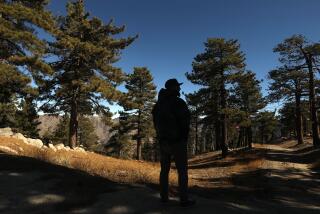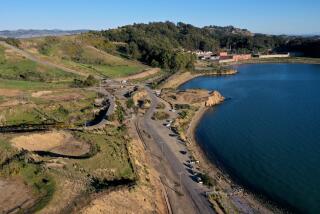Sequoia Cabin Owners Fear Losing Perch
MINERAL KING, Calif. — Here where the Sierra meets the sky, Jim Barton’s thoughts are on the land beneath his cabin. The rustic little vacation home, a 500-square-foot antique of deeply weathered wood and 76 summers of memories, is on shifting ground.
Barton’s cabin and 60 others like it in this lonely corner of Sequoia National Park are private retreats on public parkland. And therein lies the problem. The law gives federal officials the right to uproot the cabins of Mineral King once their present owners die.
Now cabin dwellers fear a new park management plan in the works could hasten the loss, a prospect that has given this quiet enclave the jitters.
Some environmentalists worry that the government could concede too much on Mineral King and set a dangerous precedent for America’s national parks, where more than 1,500 private dwellings survive as relics of a bygone era.
Controversy is nothing new here. Since the mid-1960s, when Walt Disney launched an unsuccessful bid to build a ski resort among Mineral King’s granite chutes and cirques, cabin owners have been locked in an on-again, off-again war to retain a stake in the peaceful valley.
The fight has stretched to Congress and the U.S. Supreme Court. Many predict this latest skirmish could get there too.
Summer Home for Generations
For families who summered here, generation after generation, the cabins are not just about rights on the land. They’re about tradition, mountain memories, preserving a deeply cherished way of life. Barton, like Mineral King’s other longtime summer citizens, wants his grandkids to grow old in the rough-hewn cottage his father built in 1924.
“Many of us have spent more time up here than anywhere else,” said Barton, 76. “This is home.”
Environmentalists don’t dispute the passion Barton and others feel for Mineral King. But they question why the cabin dwellers should enjoy a privilege others are denied: a vacation home in a national park.
“Those cabins have made the valley a summer resort for a fortunate few,” said David Ogden, a Mineral King visitor for 40 years. “It should be open to all equally.”
John Krebs, a former congressman from the Central Valley, is more blunt: “If they got away with their scheme, they would be taking over public land for nothing.”
And what land it is.
Approached on a harrowing, one-lane road winding 25 miles to a pine-studded bowl at 7,000 feet, Mineral King is a scenic wonder. The jagged edge of Sawtooth Peak rakes the clouds. The east valley, swept by avalanches in winter, is green with meadow grass this time of year. To the south, the twin ridges of Farewell Gap hunch.
It was over those shoulders of granite that Harry Parole, an Irish immigrant, happened upon the valley in 1862. Within a decade, prospectors discovered gold and silver. But Mineral King was geological royalty in name only. The ore was hard to extract, and the steep slopes bedeviled mules and men. Mining eventually petered out.
Instead, Mineral King became one of the early recreational way-stations in the Sierra. Old miners’ cabins became haunts for turn-of-the-century tourists fleeing the scorching Central Valley summers.
Most of the existing cabins were built in the 1920s and 1930s and are owned by the scattered offspring of the original families. The early vacation pioneers came up from places like Visalia, Fresno and Atwater. But the community included a group of Los Angeles teachers clustered in a pine-studded section dubbed “faculty flats.”
Now, generations later, the cabins of Mineral King are little changed. Few have modern conveniences, adding to the funky ambience. In some, cooking is performed on heavy old cast-iron wood stoves. A few still depend on light from kerosene lamps. There aren’t many telephones.
Barton, an avuncular retired college math professor with a neatly trimmed white mustache, came here as an infant, three-quarters of a century ago.
His father, a cattle rancher, drove Herefords up the valley to summer in the meadow. As a boy, Barton explored the canyons, fished and swam in frosty alpine lakes.
Every nook of the place has a memory.
Down that slope, he points, is where they pastured the family milk cow.
Grandpa’s cabin once stood over there, he says, gesturing to another spot. In its place is a 1950s-style A-frame.
A tiny log dwelling looms into view. Barton recalls how people used to say the place was built in a single day--and “with a case of Jack Daniel’s.”
An old red cabin yanks Barton back to the present day. The owner of record has just died. The family will probably lose the spot when the existing permit expires. No one quite knows for sure.
Around the country, owners of private abodes on federal land have grown accustomed to a precarious existence, their future in the woods dependent on shifting political winds in faraway Washington. Under some presidents, private dwellers have been pushed out. Under others, they’ve been left alone.
Such uncertainty has dogged Mineral King denizens for 35 years.
Disney started it, proposing a sprawling ski resort of 27 lifts stretching up the 11,000-foot ridgelines. The cabins were destined to be replaced by hotel rooms.
Environmentalists fought to protect the pristine valley, joined by the summer citizenry of Mineral King. They won in court, forcing Disney to reconsider its plans. The issue was settled in 1978 as Krebs punched through legislation incorporating Mineral King into Sequoia National Park.
As part of the deal, the cabin owners got a virtual death sentence for their vacation lifestyle. The law decreed they could at best hold onto the cabins until they passed away. There would be no inherited leases, no privilege passed on to future generations.
And under the 1978 act, the National Park Service retained power to boot the families if the land could be put to a “higher and better” use.
Krebs today says it was a good deal for the families, a generous concession. For a fee of less than $800 paid each year to the national park, he noted, they get a spectacular perch few Americans can claim at any price.
But the cabin dwellers remain resentful of the 1978 deal.
“With a gun to your head you do the best you can,” said Les Reynolds, a leader of the cabin contingent and, at 47, one of the youngest permit holders. “Now we’re still maneuvering and trying to finagle more time. Who can blame us?”
Park Management Reviewing Policy
If there is a sense of urgency in Mineral King, age has something to do with it. Most of the cabin owners are gray-haired, well into retirement. They want to see their kin positioned to inherit a piece of Mineral King.
In the mid-1990s, the group asked Congress to change the law and allow permits to be passed on. That move failed, in no small part because of unwavering resistance by stewards of the national park system.
Sequoia’s new management plan, a once-a-generation blueprint designed to shape public use of the park, has fanned fresh worries of eviction. Among issues being reexamined is how and how soon the cabins should be turned over to the park, and some worry the park could exercise the “higher and better” use clause in the 1978 law to hasten that process.
“There is a huge fear in this valley that the Park Service could retaliate” out of ire over the failed run at Congress, said Ruth Shepherd, a cabin owner who led the fight in Washington.
Among the options being eyed by park officials are removing the cabins to make room for more camping sites or simply returning the area to nature.
There is precedent for such action right in Sequoia. Camp Conifer, a collection of two dozen cabins a few miles west of Mineral King, was shut down and leveled in the late 1960s, left to be overrun by the forest.
Park officials say they won’t do anything in Mineral King until the management plan is completed, probably in 2002. Meanwhile, a few families have been allowed to stay on despite the death of the patriarch who held the permit.
While not tipping their hand, federal officials make no secret that private cabins run counter to the public purpose of the national parks.
“To do anything to privatize that land,” said Sequoia chief naturalist Bill Tweed, “would seem contrary to our mission.”
Environmentalists sympathize with the cabin owners, but remain resolute. Mineral King, they say, belongs to the American people, not just a privileged few.
“They’re not evil people--they love that area and want to stay there,” said Joe Fontaine of the Sierra Club. “But it is public land, and the public’s interest should come first.”
Cabin residents contend they deserve better than that. Didn’t we fight valiantly against Disney? Haven’t we been superb stewards of the land?
At the request of the cabin dwellers, the National Park Service is considering giving Mineral King federal historic status. A decision, which would cover about two-thirds of the summer cottages, is expected within the next two months.
Some cabin owners hope a historic mantle will translate into extra clout for the community. They talk of making Mineral King a sort of Williamsburg in the Sierra, a living historical district. Families would act as guardians in concert with park rangers.
But park officials are examining other visions as well.
There is the possibility of purchasing the cabins as owners die, slowly transforming the community into public lodging.
There is the prospect of working with cabin owners to let the public rent cabins when unoccupied, treating the community like a time-share complex.
There also is the possibility that the Park Service could use its powers to boot current occupants, buying the cabins and opening them for public use.
Mineral King residents are critical of all of these scenarios. They argue that the antiquated cabin infrastructure--fleeting electricity, patchwork plumbing, wood-fired cooking stoves--is too quirky to work for weekend tourists. And improvements, let alone upkeep, would prove costly.
They want to stay put, to keep their private piece of a public wonderland and see their children and grandchildren inherit the summer.
“The day we have to leave would be a very dreary day,” said Shirley Devol, a Los Angeles native who first came here with her parents in 1933. “It’s so much a part of my history, my children’s history. It would be like taking a chunk out of my body.”
More to Read
Sign up for The Wild
We’ll help you find the best places to hike, bike and run, as well as the perfect silent spots for meditation and yoga.
You may occasionally receive promotional content from the Los Angeles Times.






